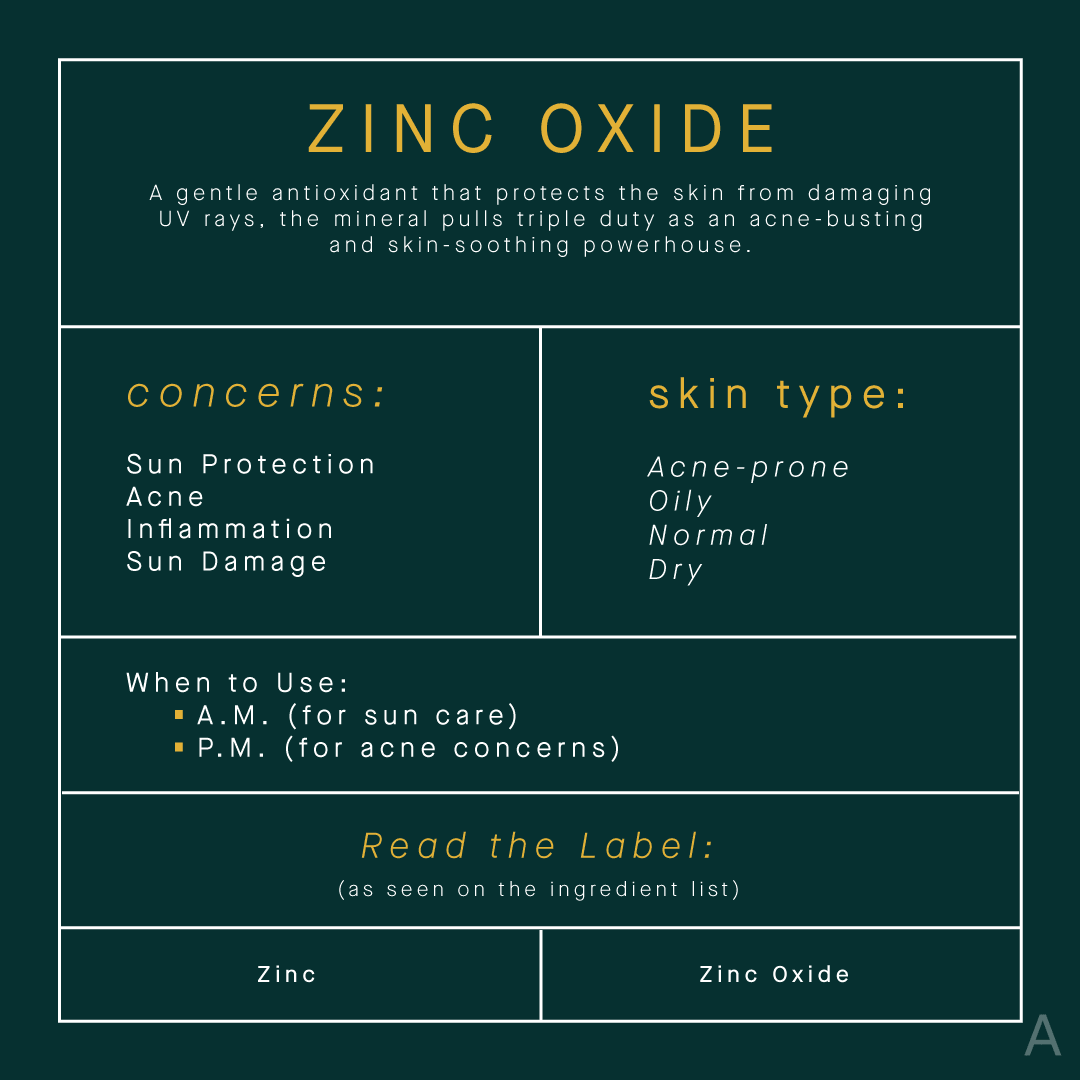 Benzoyl Peroxide
Benzoyl PeroxideRead The Label: All Of Your Zinc Oxide Questions Answered
This gentle antioxidant is known as a sun care stalwart, but did you know it does a lot more? Here’s why the mineral is more than a UV protectant.
Feel like you need a dictionary every time you look at the ingredient list of a beauty product? Still unsure of the difference between retinol and retinoids? What about the unique benefits of vitamins B, C, and E? Are alpha and beta hydroxy acids the same thing? The skincare aisle can be overwhelming, but you don’t need a PhD in cosmetic chemistry to navigate it. With expert help, The AEDITION is demystifying and simplifying the beauty industry — one label at a time.
We often discuss the benefits of sun protection and why ultraviolet (UV) rays are damaging to the skin, but we have yet to delve into the hero ingredient that allows physical sunblocks to do their job. Allow us to introduce you to zinc oxide. The soothing mineral provides broad spectrum blocking of the sun’s rays and is gentle enough for sensitive skin – hey, it’s safe enough for babies to wear!
With that said, it’s hard to believe zinc oxide can do even more good, right? Well, apart from working as an antioxidant, it also offers anti-inflammatory benefits for acne-prone skin and helps other ingredients in your skincare and wellness routine shine. The AEDITION spoke with skincare experts to learn more about the benefits of zinc oxide and how to incorporate it into your regimen.
What Is Zinc Oxide?
In simplest terms, zinc oxide is a white, powdery mineral that is used in a wide range of skincare, cosmetics, and personal care products, including sun protection, makeup, bath soaps, and more. “Zinc oxide is a naturally occurring white mineral found in zincite,” says Joshua Ross, a celebrity aesthetician for Sonage and founder of SkinLab in Los Angeles. “This mineral can be combined with other ingredients to give it a tint that matches natural skin tones.”
Providing the broadest spectrum UVA and UVB protection (the former causes sun damage, while the latter leads to sunburns), zinc oxide is approved by the United States Food and Drug Administration (FDA) for use as an active ingredient in sunscreen. For that reason alone, it should be a mainstay in any skincare regimen, but it actually does even more for the skin. “Besides supporting skin healing for decades, zinc oxide today is a common active ingredient found in physical sunscreens, diaper rash creams, calamine lotions, etc.,” explains Amy Spizuoco, DO, a board certified dermatologist and founder of True Dermatology in New York City. “Zinc oxide is most commonly added to topical solutions such as moisturizers, sunscreens, and makeup products like foundations.”
The Benefits of Zinc Oxide in Sun Care & Skincare

Where do we begin? Ross explains that, “in addition to sun protection, zinc has benefits including reducing inflammation, soothing, and promotes healing for scars and wounds, and can help keep conditions like eczema and psoriasis under control.” It also supports the skin barrier. “Additionally, the barrier formed by zinc oxide on the skin also helps to reduce transepidermal water loss, or TEWL, contributing to long-lasting moisturization,” notes Harry Fallick, MD, a plastic and reconstructive surgeon and founder of CoTZ. One notable misconception about the mineral: That it clogs pores. “The particles are too large to penetrate the pore, so they sit on top of the pore acting as skin protection and barrier which can keep pollutants out of the skin,” Ross adds.
In sun care, zinc oxide is one of two physical blockers (alongside titanium dioxide) that can be used in sunscreen. “Zinc oxide works by ultimately refracting and reflecting UV rays away from the skin,” Dr. Fallick explains. “It does not absorb into the skin or the bloodstream and is very gentle, making it perfect for sensitive skin, children, or post-procedure use.” This hopefully doesn’t need repeating, but sun protection is not just for aesthetic benefits. “Not having significant sun protection can lead to sunburn,” Dr. Spizuoco warns. “Having five or more sunburns doubles your risk for melanoma, the deadliest form of skin cancer.”
Adequate sun protection is the best defense against all types of skin cancer. “This is why I wanted to create a product that is accessible and easy to use, two of my colleagues had skin cancers removed and application, as well as reapplication, is incredibly important when it comes to sunblock,” explains Samantha Brett, the founder of Australian suncare brand Naked Sundays. She acknowledges that, in the past, sunblocks with zinc oxide have gotten a bad rap for being thick, difficult to rub in, and leaving a white-cast on the skin. Fortunately, product formulations have come a long way and mineral sunscreens can now have a virtually translucent finish.
The Benefits of Zinc in Food
This article is about the benefits of topical zinc oxide, but we’d be remiss not to mention the role it plays in diet and nutrition. Zinc is not naturally produced by the body, but it is an essential mineral for many bodily functions. It fortifies the immune system, aids in brain development and memory, and prevents cellular damage (to name a few). Recent studies have found that it can also help alleviate the oxidative stress that leads to certain chronic diseases – especially ones that crop up with age. Foods such as chickpeas, red meat, shellfish, and cashews are good sources of zinc. If you are not getting enough zinc through your diet, supplementation may be an option.
The Best Candidates for Zinc Oxide
Due to zinc oxide’s soothing properties, anti-inflammatory benefits, and versatility, everyone is a candidate for a zinc-powered product – though the type of product you use will depend on your skin type. Those with acne-related concerns may be using a topical with zinc oxide, as per their dermatologist’s recommendations. And if you have some calming products in your over-the-counter skincare routine, there is a good chance zinc oxide is making an appearance.
There is no excuse not to wear sunscreen every single day, no matter the weather, but those with acne or other skin sensitivities may be wary of adding any potential irritants to their complexion. Mineral sunscreens with zinc oxide and titanium dioxide are widely considered to be the gentlest and safest sun care products. “Zinc oxide does not cause any severe side effects, and cases of allergic reactions due to zinc oxide are rare,” Dr. Spizuoco shares. She does, however, advise women who are pregnant or breastfeeding to consult with their doctor before introducing new products to their routine.
How to Find the Right Zinc Oxide Product
At this point, you hopefully realize that you’re not only going to see zinc oxide listed on sunscreen tubes. If you have acne or other inflammatory skin conditions or are simply looking for a calming addition to your skincare routine, there is a case to be made for the mineral. Here’s what to look for:
Sun Care
When it comes to zinc oxide in sunscreen, Ross recommends finding a product with no less than 10 percent. “This is regardless of SPF claims – be it 20, 30, or 40,” he says. “We know that 10 percent zinc will provide the needed protection to block out UVA, as well as UVB rays.” The exception to this 10 percent rule is formulas that pair zinc oxide with other actives that enhance its efficacy. CoTZ sunscreens, for example, combine zinc oxide and titanium dioxide because “you can achieve a higher SPF with a lower total percentage of total active ingredients than with zinc oxide alone, while still achieving good UVA coverage,” Dr. Fallick explains. This is because “zinc oxide both complements titanium dioxide’s protective abilities and extends photoprotection to the skin where titanium dioxide is insufficient,” he adds.
To ensure you don’t miss a spot when applying, Ross suggests reaching for a tinted formula due to its visibility. “If you have coverage, you have protection,” he says. “If you don’t have the coverage, you don’t have protection.” For a hint of tint, try the Aforé Beauty Smooth Shade Tint Sunscreen or CoTZ Flawless Complexion SPF 50 Tinted. If you prefer a sheer option, we’re fans of the Sonage Protec Plus Mineral Sunscreen and Babor DOCTOR BABOR Protect RX Mineral Sunscreen SPF 30.
Makeup
Skincare ingredients in makeup is a long-debated topic – are their concentrations strong enough to provide any real benefits? Be it a tinted SPF or a complexion product packed with zinc oxide (we like Thrive Causemetics Buildable Blur CC Cream), zinc oxide acts as a thickening agent to give your skin the protection it needs.
While beauty products shouldn’t replace your skincare staples, a zinc oxide-powered primer (shout out to the Naked Sundays SPF 50+ Collagen Glow 100% Mineral Perfecting Priming Lotion) can pull double duty to protect and provide some grip. “We’ve formulated our products with good-for-you ingredients, such as vegan collagen, so that you get the most from your wear,” Brett notes.
Skincare
While we categorize sun care as skincare (afterall, it’s the prevention around), zinc oxide can be found in non-SPF products formulated to treat sensitive or acne-prone skin types. In the Plantkos Phyto Replenishing Facial Essence, micronutrients like calcium, selenium, iron, and zinc join forces with rose water, chamomile, licorice root, and probiotic ferment to help calm inflammation and prepare skin for the optimal absorption of whatever products come next in your routine.
For banishing breakouts, the mineral can be paired with benzoyl peroxide or salicylic acid – as found in the JORI Skincare Daily Leave-On Acne Treatment Mask and Bliss Clear Genius Acne Spot Treatment – for soothing oil and shine control.
The Takeaway
If only for its UV-protecting properties, zinc oxide is a skincare stalwart. But this calming mineral also provides soothing benefits that are particularly appreciated by those acne-prone and sensitive skin types. From morning ‘til evening, zinc oxide deserves a spot in your sun care and skincare routines.
All products featured are independently selected by our editors, however, AEDIT may receive a commission on items purchased through our links.
More Related Articles
Related Procedures

AI Plastic Surgeon™
powered by'Try on' aesthetic procedures and instantly visualize possible results with The AI Plastic Surgeon, our patented 3D aesthetic simulator.


